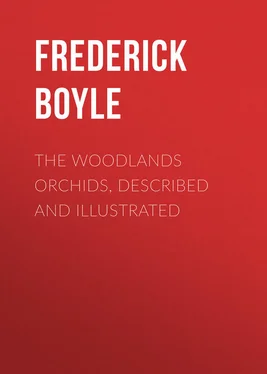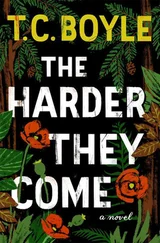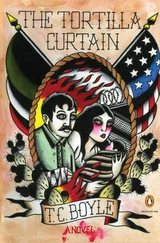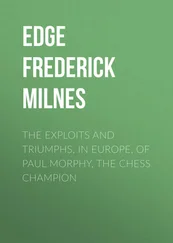Frederick Boyle - The Woodlands Orchids, Described and Illustrated
Здесь есть возможность читать онлайн «Frederick Boyle - The Woodlands Orchids, Described and Illustrated» — ознакомительный отрывок электронной книги совершенно бесплатно, а после прочтения отрывка купить полную версию. В некоторых случаях можно слушать аудио, скачать через торрент в формате fb2 и присутствует краткое содержание. ISBN: , Жанр: foreign_antique, foreign_prose, на английском языке. Описание произведения, (предисловие) а так же отзывы посетителей доступны на портале библиотеки ЛибКат.
- Название:The Woodlands Orchids, Described and Illustrated
- Автор:
- Жанр:
- Год:неизвестен
- ISBN:http://www.gutenberg.org/ebooks/32205
- Рейтинг книги:5 / 5. Голосов: 1
-
Избранное:Добавить в избранное
- Отзывы:
-
Ваша оценка:
- 100
- 1
- 2
- 3
- 4
- 5
The Woodlands Orchids, Described and Illustrated: краткое содержание, описание и аннотация
Предлагаем к чтению аннотацию, описание, краткое содержание или предисловие (зависит от того, что написал сам автор книги «The Woodlands Orchids, Described and Illustrated»). Если вы не нашли необходимую информацию о книге — напишите в комментариях, мы постараемся отыскать её.
The Woodlands Orchids, Described and Illustrated — читать онлайн ознакомительный отрывок
Ниже представлен текст книги, разбитый по страницам. Система сохранения места последней прочитанной страницы, позволяет с удобством читать онлайн бесплатно книгу «The Woodlands Orchids, Described and Illustrated», без необходимости каждый раз заново искать на чём Вы остановились. Поставьте закладку, и сможете в любой момент перейти на страницу, на которой закончили чтение.
Интервал:
Закладка:
Of course there are many varieties of Cattleya gigas, for it is truly said that two blooms of orchid exactly alike cannot be found. But I shall mention only two.
Imschootiana is huge even above its fellows, for a flower may be nine inches across; the colour of sepal and petal mauve, with a crimson-purple lip of splendour beyond conception. The golden throat under a crimson-purple tube is lined with bright crimson; the characteristic ‘eyes’ gamboge, fading to white.
Sanderae. – Some may well think this the loveliest of all its lovely kin. Probably it is a foreign strain, though remote, which gives such supreme softness to the magenta of the lip. On that ground the golden ‘eyes’ shine forth with an abruptness positively startling. The broad sepals and petals are sweetest rosy-mauve. Even the tube is deep crimson.
Here also is Cattleya bicolor Measuresiana, an exquisite example of a species always charming to my taste. In this instance the sepals and petals are purest and smoothest olive green; the very long shovel-shaped labellum magenta-crimson, outlined and tipped with white.
Of Cattleya aurea again the varieties are many. It was brought from Antioquia, New Granada, by Wallis, in 1868. If crimson and yellow, tastefully disposed, make the most gorgeous combination possible, as all human beings agree, this and its sister Dowiana are the most gorgeous of flowers. The ordinary form of Cattleya aurea is nankin yellow, but in the variety R. H. Measures , sepal and petal are gamboge. The glorious lip, opening wide from the very base, has long brownish blurs descending from the throat, on a golden ground which fades to yellow towards the edge. There are two clear crimson patches in the front, and the margin is clear crimson, whilst the whole expanse is covered with fine stripes of crimson and gold alternately.
We come to the hybrids of these two which, dwelling side by side, have been intermarrying for ages; and their offspring again have intermarried, forming endless combinations. Cattleya Sanderiana was first discovered under circumstances rather odd. One of Messrs. Sander’s collectors, Mr. Mau, was hunting for Odontoglossum crispum by Bogota. He came upon a number of Cattleyas – none of them in bloom – and gathered any that came in his way, taking no trouble, nor even mentioning the incident in his letters. In due course he brought them to St. Albans along with his Odontoglossums. Mr. Mau said nothing even while the cases were being unpacked. Apparently he had forgotten them.
‘What are these Cattleyas?’ asked Mr. Sander, in surprise.
‘Oh, I don’t know! I found them in the woods.’
Old spikes still remained upon the plants, and bunches of withered rags at the end. Mr. Sander perceived, first, that the flower must be gigantic beyond belief; next, that it was red.
‘Go back by next mail!’ he cried. ‘Search the woods – gather every one!’ And Mr. Mau did actually return by next mail.
This was Cattleya Sanderiana – sometimes as much as eleven inches across; in colour, a tender rosy-mauve. The vast lip is almost square, with a throat of gold, lined and netted over with bright crimson. It has the charming ‘eyes’ of gigas in perfection, and the enormous disc, superbly frilled, is of the liveliest magenta crimson.
Chrysotoxa , another of these wondrous hybrids, ‘favours’ its aurea parent; with buff-yellow petals and sepals, the lower of which hang in a graceful bunch surrounding the huge lip of dark orange ground, with an edging of maroon-crimson, narrow above, widening to a stately breadth below; the whole closely covered with branching lines of crimson.
Mrs. Fred Hardy is a third – divinely beautiful. White of sepal and petal, with the vast magenta-crimson lip of Hardyana. The glorious effect may be in part imagined.
We have yet a fourth of this amazing group – Trismegistris – most nearly allied to Sanderiana. I have not seen this variety in bloom; it was introduced only three years ago. But the name signifies that it is the quintessence of all. Individual taste may not always allow that claim, but no one disputes that it is at least equal to the finest.
But the thoughtful cannot contemplate these wondrous things with satisfaction unalloyed. Unless some wealthy and intelligent persons in South America undertake to cultivate them in a regular way, it is too probable that in a generation or two they will be utterly lost; for we cannot hope that the specimens in Europe will endure so long, however vigorous they may be at present. Here is the letter which accompanied the last consignment – sad reading, as I think: —
Medellin, January 27, 1896 .Messrs. F. Sander and Co.,
St. Albans.
Gentlemen – I arrived here yesterday from Alba Gumara and received your much honoured letter of November 11, 1895. I shall despatch to-morrow thirty boxes, twelve of which contain the finest of all the aureas, the Monte Coromee form, and eighteen cases contain the grand Sanderiana type, all collected from the spot where these grow mixed, and I shall clear them all out. They are now nearly extinguished in this spot, and this will surely be the last season. I have finished all along the Rio Dagua, where there are no plants left; the last days I remained in that spot the people brought in two or three plants a day and some came back without a single plant. I left my boy with the Señor Altados to explore while I despatched the boxes and get funds, when I shall return for the var. papilio which Altados promised to secure for me, and go on up to the spot called the Parama San Sausa. In the boxes containing the aureas you will find about 300 seedlings which have not flowered; these are from a grove of trees where no plants have previously been gathered from, and where the finest Sanderianas and aureas grow intermingled in one family. These Cattleyas only flower once in a year – that is, from March to the end of July, and both kinds together. Some of the flowers measure upwards of 10 inches – and on a spike you can have nine flowers. I cannot wait in that fearful region longer than the flowering time; the awfully wild aspect of everything and scarcity of wholesome food and help for the work is simply maddening. If I shall find the other orchids you want I do not know. My boy is gone with Altados for the Oncidium. You may believe me that many more of these fine Cattleyas do not exist, and I can, after all, perhaps not find so good as may be in those you will now receive.
In the last years I have seen these plants in bloom, when I was so ill with fever, and in no other place can you get such a fine type.
The plants that I planted when I was taken ill no one found; no one has been here, and the plants had grown well and some of them very much rooted.
Trusting that all will arrive in good order, I remain, gentlemen, your very obedient servant,
Carl Johannsen.The next division is styled the Mendelii house; more than three hundred large examples of this species – to be accurate and pedantic, it should be called a variety – occupy the centre, a hundred and eighty the stand to right.
Cattleya Mendelii lives in the neighbourhood of Ocaña, New Granada, at an altitude of 3500 feet. It was introduced by Messrs. Backhouse in 1870, and named in honour of Mr. Sam Mendel, a great personage at Manchester in his day. Distinctions of colour are very frequent. Some pronounce it the loveliest of Cattleyas.
Among the noble specimens here, many of them chosen for individual peculiarities, not half a dozen are named; the rest bear only letters showing their class, and certain marks understood by the initiated. It will be a relief when this system, or something like it, becomes general. And the time is not distant; at least, the privilege of granting new names at will must be restricted among those who obey the authorities.
Читать дальшеИнтервал:
Закладка:
Похожие книги на «The Woodlands Orchids, Described and Illustrated»
Представляем Вашему вниманию похожие книги на «The Woodlands Orchids, Described and Illustrated» списком для выбора. Мы отобрали схожую по названию и смыслу литературу в надежде предоставить читателям больше вариантов отыскать новые, интересные, ещё непрочитанные произведения.
Обсуждение, отзывы о книге «The Woodlands Orchids, Described and Illustrated» и просто собственные мнения читателей. Оставьте ваши комментарии, напишите, что Вы думаете о произведении, его смысле или главных героях. Укажите что конкретно понравилось, а что нет, и почему Вы так считаете.












